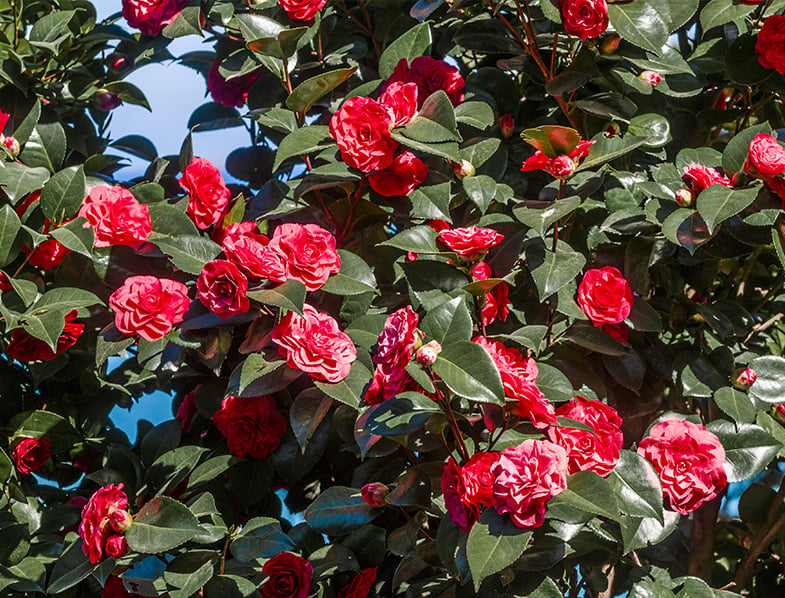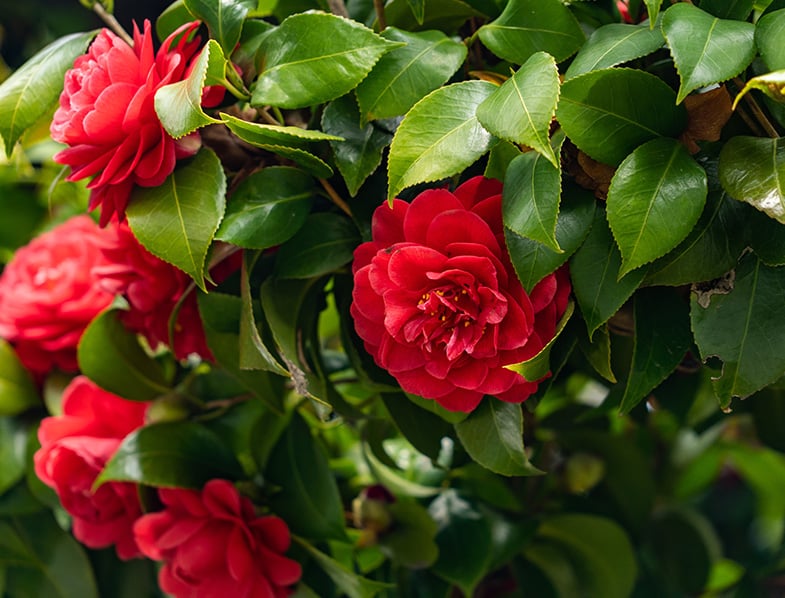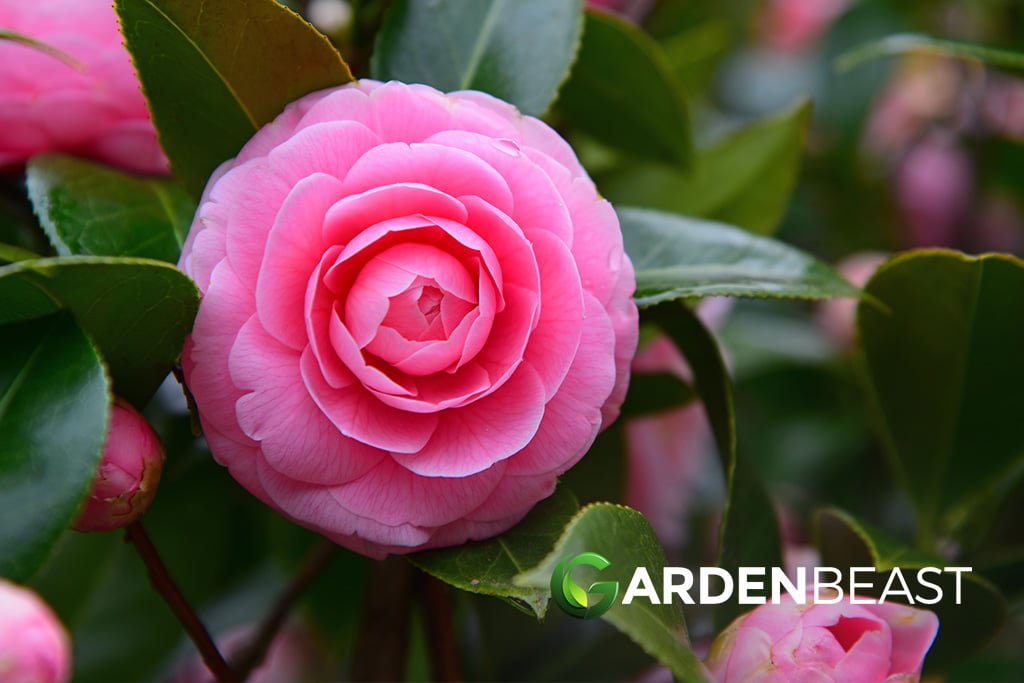As we always say, you can never have too many plants as your companions! And if you are a big lover of flowering plants, there is no chance you can resist these alluring species. Camellias are very popular and distinguished ornamental houseplants, so you need to welcome at least one specimen into your collection! Especially when you have so many varieties to choose from!
Camellia Japonica is one of the well-known species that belongs to the Camellia genus. This superb plant comes by many names, such as the Japanese Camellia, Common Camellia, Rose of Winter, or Tsubaki in Japanese.
Camellia Japonica plants can be considered iconic in many regions worldwide. Since the 11th century, for example, they have appeared in several gorgeous pieces of art from China including paintings and porcelain. In the past, these plants were used as offerings to the gods and they are still seen today as lucky symbols for the Chinese New Year.
With more than 2000 cultivars developed, Camellia Japonica species are valued mostly for their lovely flowers. Although these plants have been cultivated in the Orient for thousands of years, they were introduced into Europe and the United States during the 18th century. They have a wide range of colors, patterns, shapes of flowers, and more than 30 cultivars have gained the prestigious Award of Garden Merit.
About Camellia Japonica
- Camellia Japonica plants have several medicinal uses including anticancer activity. The flowers of these plants are tonic, astringent, hemostatic, and antihemorrhagic. The leaves have rich anti-inflammatory properties.
- Their leaves are a tea substitute, while the dried flowers can be cooked and used in a recipe of Japanese food called ‘mochi’. Some people prepare edible oil from their seeds.
- Chinese women refrained from wearing a Camellia Japonica in their hair due to the late opening of the bud. This fact is believed to signify that they would not be blessed with a son for a long time.
- The leaves are a tasty source of food for a few tiny creatures. They are often eaten by some Lepidoptera caterpillars including Ectropis Crepuscularia (the engrailed).
- The flowers of Camellia Japonica are highly attractive to pollinators like Zosterops Japonica, a species of birds commonly known as the Japanese white-eye.
- Camellia Japonica is native to mainland China, southern Korea, Taiwan, and southern Japan. This plant grows in forests at high altitudes and near the coast down to sea level.
- There are no toxic effects reported for these plants, so you can grow them safely around curious pets and children.
- Camellia Japonica is an excellent companion for ferns, hostas, azaleas, magnolias, witch hazel, or Japanese maple.

Camellia Japonica Features: An Overview
- They belong to the Theaceae family that contains many species of ornamental camellias and the economically important tea plant.
- Camellia Japonica is a flowering shrub or tree that can reach between 7 to 12 feet (2-3.6 m) in height and 5 to 10 feet (1.5-3 m) in width. Some varieties have grown much taller than usual at about 36 feet (11 m).
- These plants are composed of many branches. They are purplish-brown when younger and turn grayish to brown with age.
- The foliage is formed of leathery, dark green on top, and pale green underside leaves that grow alternately arranged on branches. The edges are very finely toothed, with the base and the tips quite pointed.
- Their leaves usually measure from 2 to 4.3 inches (5-11 cm) in length and 1 to 2.4 inches (2.5-6 cm) in diameter. They have tiny stalks of about 0.2-0.4 inches (5-10 mm).
- In the wild, Camellia Japonica plants bloom from January to March. The flowers grow in pairs or alone on very short stems.
- The most common forms in which their flowers appear are single, semi-double, or double with extra petals. They come in various shades of red, orange, yellow, lavender, pink, or white.
- From September to October, Camellia Japonica bears globe-shaped fruits that have three compartments. Each section of the fruit contains one or two brown seeds.
- Their seeds can be used in propagation and usually germinate in one to three months. They must be grown in light shade in a greenhouse-like environment after kept in warm water for a day.

Growing Camellia Japonica
In general, Camellia Japonica plants grow at their best and bloom sporadically when grown in partial shade. They prefer plenty of morning sunlight with some dappled shade in the afternoon. Make sure you protect your plants from harsh sunlight, as this can scorch their leaves and affect their overall health.
Temperature-wise, they do not handle sudden environmental changes very well. Camellia Japonica plants are somehow cold-hardy in temperatures that drop to 10 °F (-12 °C), but not for long periods. When it comes to indoor plants, it is suggested you grow them in temperatures that range from 45 to 61 °F (7-16 °C). Also, they cannot tolerate temperatures above 64 °F (18 °C) for too long.

Planting Camellia Japonica
Camellia Japonica plants do not enjoy growing in soils with high pH levels, such as neutral to alkaline types. Plant your babies in a slightly acidic soil that has good drainage to avoid stressing them out. You must also look for soil that is rich in nutrients and organic matter.
They usually grow by themselves without any extra fertilizing, but you can provide them with some fertilizers if you want to boost their growth. Feed your Camellia Japonica with an acid-forming camellia or azalea fertilizer after the flowers have dropped in spring. If the growth seems lazy or the leaves are scarce and lost their color, feed your plant again in midsummer.
Like most shrubs, Camellia Japonica requires regular pruning after the blooming period has ended. You can cut off any weak or dead branches and even thin out the growth if it is too dense for the flowers to open properly. Moreover, the spent flowers can also be removed to ensure healthy new growth and proper future blooming.
Although not many, you will encounter some pests and fungal diseases when growing Camellia Japonica plants. They may be bothered occasionally by scale insects, aphids, and mites. You can treat the infected parts with rubbing alcohol, neem oil, or suitable insecticides.
A disease of the flowers called petal blight can also occur in February or March and can be identified through brown splotches. There is no cure for this disease, but you can remove the unhealthy blooms to prevent any spread. They can also be affected by dieback, a common disease that can be prevented by using sterilized pruning shears, sanitation, and fungicides.
- Starter Plugs are grown in trays and therefore will be SHIPPED WITHOUT A POT!! We will do our best to keep the soil and rootball intact by wrapping each plant
- Deep red buds open to beautiful peony type red blooms with a delightful fragrance. Flowers are a great contrast to the glossy, dark green foliage
- An old favorite for milder regions of the U.S. blooms Jan - March. Great for use in shade gardens
- MATURE HEIGHT : 6-8 feet -- MATURE WIDTH : 6-8 feet -- EXPOSURE : Full to partial shade -- HARDINESS ZONES : 7-10
- Listed price is for ( 1 ) starter plant - FOR FLOWERING PLANTS, WE CAN NOT GUARANTEE BLOOMS AT TIME OF PURCHASE
- We cannot ship our plants to the following states: AK, AZ, CA, CO, HI, ID, MT, NM, NV, OR, UT, WA, or WY. All orders to these states will be automatically cancelled.
- At matured height, this evergreen can grow up to 6-10 feet tall and as wide.
- Lives best in zones 7-9 and like partial sun to partial shade. Although it can be cold hardy, it does not like sudden temperature changes or extreme heat from the sun.
- Grows in zones 6-10 and prefers partial to full sun and moist, well-drained soil.
- Botanical Name: Camellia japonica ' Kramer's Supreme'
- Starter Plants are grown in trays and therefore will be SHIPPED WITHOUT A POT - ( SCROLL PICS TO SEE SIZE OF ACTUAL PLANTS FOR SALE )
- Produces formal double petal blooms, white or light pink with darker pink tips. The bloom is smaller (about 3 inches), Blooms mid to late season (Feb to March) with dark glossy leaves
- Grace albritton prefers slightly acidic soils with filtered sun to shade.Great for use in shade gardens, woodland plantings, as specimen plants, or in large container gardening. Evergreen.
- MATURE HEIGHT : 8-10 feet -- MATURE WIDTH : 6-8 feet -- EXPOSURE : Full to partial shade -- HARDINESS ZONES : 7-10
- The listed price is for ( 1 ) starter plant - ( SCROLL PICS TO SEE SIZE OF ACTUAL PLANTS FOR SALE ) Plants may be shipped dormant when ordered From November thru March We CAN NOT guarantee plants will have flowers at time of purchase Starter Plants are not large established plants and are not meant to be planted directly into the landscape. All starter plants should be potted and kept in a protected area where it can receive some tlc for at least 6mo to 1 year before planting.
Last update on 2024-09-29 / Affiliate links / Images from Amazon Product Advertising API
Watering Camellia Japonica
As with most shrubs, Camellia Japonica requires extra attention only during times of extreme drought or when freshly planted. Keep the soil constantly damp until your plant is established in its growing medium. After three years or so, when your plant has settled in well, it will survive with little water.
Make sure you inspect the soil in-between waterings to avoid over-watering these plants. When the soil is well-drained, your Camellia Japonica is ready for a new good soaking. As a general rule, you must always water fertilized plants generously after each application.
Propagating Camellia Japonica
Camellia Japonica plants can be, without a doubt, the center of interest in every garden or household. Their beautiful flowers can fill the heart of any plant-lover and make for an excellent gift to a beloved friend or family member. Luckily, they can be propagated pretty simply through stem cuttings even by inexperienced gardeners.
The cuttings respond well to propagation if they are taken in late spring or early summer. Look for healthy stems that contain at least six leaf nodes and cut just behind the sixth one. Remove all the leaves and leaf nodes from the cuttings except for the top two or three ones. For optimal results, dip the cuttings into rooting hormone before planting them.
Fill a container that is 4 to 6 inches (10-15 cm) deep with half of both peat moss and coarse sand. After this process, provide the substrate with plenty of water until the soil is damp to the touch and remove any excess water from the tray. During the rooting process, the soil should be maintained moist but not soggy.
Plant the cuttings in the growing medium and place the container in a warm location where they can also receive bright, indirect light. You must cover the container with a plastic bag or wrap to create an environment similar to a greenhouse. For several times per day, open the plastic to mist the cuttings with distilled water and check for mold growth. If some cuttings seem musty or dead, you need to remove them immediately.
The cuttings should develop a healthy root system after three months or so. Pull the leaves gently and if you notice some type of resistance, the cuttings are ready for individual growth. Transplant your Camellia Japonica babies into their own pots and care for them as for their mother plant.

In Conclusion
Camellias are spectacular flowering plants and they’re very difficult to ignore. Besides their easy-going style, these plants come along with splendid foliage and flowers in many beautiful colors. They can also be propagated by any type of gardener, so you can keep them alive for decades!
Are you growing Camellias? Share your experience in the comments!




1 Comment
I will not try to count how many Camellias we have planted that have not lived. We have one “Debutante” that has lived for about five years but has not grown much and few blossoms in the March-April. I went to a camellia show south of my city and the gardeners pulled up numerous new plants coming up under the gigantic shrubs. Each of the guests that wanted new plants came home with at least five each. I have one or two to live for 3 years. They are all gone now. We just bought two more camellias last week. They are in the ground. do we need to go pray over them everyday? We bought a white (2nd one to try) and a red( 2nd one) Kramers Supreme was the red one that did not live .
Help